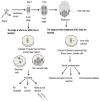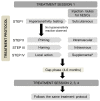A review of the emerging potential therapy for neurological disorders: human embryonic stem cell therapy
- PMID: 28533935
- PMCID: PMC5435646
A review of the emerging potential therapy for neurological disorders: human embryonic stem cell therapy
Abstract
The first human embryonic stem cell (hESC) line was developed in the late nineties. hESCs are capable of proliferating indefinitely and differentiate into all the three embryonic germ layers. Further, the differentiation of hESC lines into neural precursor cells and neurons, astrocytes and oligodendrocytes showed their potential in treating several incurable neurological disorders such as spinal cord injury (SCI), cerebral palsy (CP), Parkinson's disease (PD). In this review, we will discuss the global scenario of research and therapeutic use of hESCs in the treatment of neurological disorders. Following this, we will discuss the development of a unique hESC line, how it differs from the other available hESC lines and its use in the treatment of neurological disorders. hESCs were isolated from mixture of neuronal and non-neuronal progenitor cells in their pre progenitor state in a Good Laboratory Practices, Good Tissue Practices and Good Manufacturing Practices compliant laboratory. Blastomere cells have served as a source to derive the hESCs and the xeno-free culture was demonstrated to be more safe and effective in clinical therapeutic application of hESCs. All the patients showed a remarkable improvement in their conditions and no serious adverse events were reported. This study concluded that hESC lines could be scalable and used in the treatment of various neurological disorders such as SCI, CP, and PD.
Keywords: Parkinson’s disease; Stem cell lines; cerebral palsy; spinal cord injury; stem cell therapy; transplantation.
Conflict of interest statement
None.
Figures




References
-
- Ozolek JA, Jane EP, Esplen JE, Petrosko P, Wehn AK, Erb TM, Mucko SE, Cote LC, Sammak PJ. In vitro neural differentiation of human embryonic stem cells using a low-density mouse embryonic fibroblast feeder protocol. Methods Mol Biol. 2010;584:71–95. - PubMed
-
- Evans MJ, Kaufman MH. Establishment in culture of pluripotential cells from mouse embryos. Nature. 1981;292:154–156. - PubMed
-
- Resnick JL, Bixler LS, Cheng L, Donovan PJ. Long-term proliferation of mouse primordial germ cells in culture. Nature. 1992;359:550–551. - PubMed
Publication types
LinkOut - more resources
Full Text Sources
Other Literature Sources
Miscellaneous
